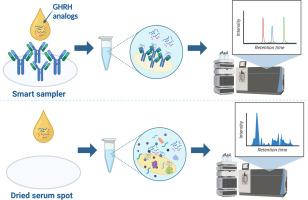Development of smart samplers and their comparison to dried serum spots for the analysis of growth hormone releasing hormone analogs using LCHRMS/MS
IF 6.5
Q1 CHEMISTRY, ANALYTICAL
引用次数: 0
Abstract
Growth hormone-releasing hormone (GHRH) analogs, including sermorelin, CJC-1295, and tesamorelin, are prohibited in sports due to their performance-enhancing potential. Detecting these peptides remains challenging, requiring sensitive analytical techniques. This study explores the feasibility of dried serum spots (DSS) and smart samplers for detecting GHRH analogs in human serum using liquid chromatography-high-resolution tandem mass spectrometry. Smart samplers combine sampling and sample preparation in one tool; in this study smart samplers were developed using divinyl sulfone functionalized paper to immobilize antibodies for selective analyte capture. DSS and smart samplers were compared for extraction efficiency, precision, and detection capabilities. Various extraction approaches were evaluated to optimize analyte recovery followed by a blind sample study to assess detection capability at unknown concentrations. Results showed that DSS yielded higher overall signal intensities but exhibited greater variability. In contrast, smart samplers demonstrated improved reproducibility and sensitivity at lower concentrations. Smart samplers successfully identified sermorelin at 0.25 ng∙mL-1, CJC-1295 at 4 ng∙mL-1, and tesamorelin at 2.5 ng∙mL-1, while DSS exhibited limitations at these concentrations. This study presents a proof-of-concept for using smart samplers and DSS in anti-doping analysis. While the results shown are promising, further optimization is needed to improve analyte recovery and sampler stability. The findings support the potential of alternative blood sampling techniques in doping control and peptide biomarker analysis.

LCHRMS/MS分析生长激素释放激素类似物的智能采样器的研制及其与干血清点的比较
生长激素释放激素(GHRH)类似物,包括血清素、CJC-1295和替沙莫瑞林,由于它们具有提高成绩的潜力,被禁止在体育运动中使用。检测这些肽仍然具有挑战性,需要灵敏的分析技术。本研究探讨了使用液相色谱-高分辨率串联质谱法检测人血清中GHRH类似物的干燥血清斑点(DSS)和智能采样器的可行性。智能采样器将采样和样品制备结合在一个工具中;在本研究中,使用二乙烯基砜功能化纸开发了智能采样器,用于固定抗体以进行选择性分析物捕获。比较了DSS和智能采样器的提取效率、精度和检测能力。评估了各种提取方法,以优化分析物回收率,随后进行了盲样研究,以评估未知浓度下的检测能力。结果表明,DSS产生了更高的整体信号强度,但表现出更大的变异性。相比之下,智能采样器在较低浓度下表现出更好的再现性和灵敏度。智能采样器成功地鉴定出0.25 ng∙mL-1的血清素、4 ng∙mL-1的CJC-1295和2.5 ng∙mL-1的替沙莫瑞林,而DSS在这些浓度下表现出局限性。本研究提出了在反兴奋剂分析中使用智能采样器和DSS的概念验证。虽然结果显示很有希望,但需要进一步优化以提高分析物回收率和进样器的稳定性。这些发现支持了替代血液采样技术在兴奋剂控制和肽生物标志物分析中的潜力。
本文章由计算机程序翻译,如有差异,请以英文原文为准。
求助全文
约1分钟内获得全文
求助全文

 求助内容:
求助内容: 应助结果提醒方式:
应助结果提醒方式:


